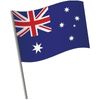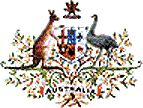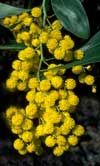In Australia, as well as other countries, there are many national symbols. There are also provincial and regional symbols too. These symbols of Australia include the different flags, animals and birds that can be found there. Some other notable Australian symbols are sports teams, art works and buildings.
Australian National Flag

The present Australian flag was formally established in the Flags Act 1953. The Australian Flag consists of three parts set on a blue field:
- the Union Jack in the upper left quarter of the flag represents the link with Great Britain
- the body of the flag has the five stars of the Southern Cross constellation, the smallest has five points, the rest have seven points
- the seven-pointed Commonwealth Star beneath the Union Jack
represents the Australia’s federal system. Originally, the Commonwealth Star had six points for the six states, but in 1908 a seventh point was added to represent the
territories of the Commonwealth.
Australian Coat of Arms

The Coat of Arms was first granted by King Edward VII by Royal Warrant on 7 May 1908. Amendments incorporating specific references to the States were approved, on the recommendation of the Commonwealth Government, by King George V by Royal Warrant on 19 September 1912.
- the Coat of Arms depicts a shield of six parts with representations of the badges of the six States
- above the shield is the crest, with the seven-pointed gold star of Federation resting on a blue and gold wreath
- on either side of the shield is a kangaroo and emu resting on ornamental supports
- beneath the kangaroo and emu are small branches of flowering wattle
- beneath the wattle is the word ‘Australia’
There is no official reason why the kangaroo and emu were chosen over other native Australian animals. The popular belief (often said in school) is that those two animals were chosen because neither can move backwards easily. As a result they symbolized a nation moving forward.
The kangaroo, of course, was an obvious choice as it is instantly recognized as Australian. Personally, we believe that the emu was chosen to give balance to the other side of the coat of arms design. Had they used a koala (another obvious choice) the design would have seemed unbalanced due to the size difference between the koala and the kangaroo. But that’s just a guess.
Australia’s National Gemstone

On 28 July 1993 the opal was officially proclaimed as Australia’s national gemstone. It is quite fitting because 95% of the world’s supply of opal comes from the desert regions of central Australia. Opal is also the birthstone for October.
Unlike other minerals, opals are not crystalline. They are created when ground water mixes with silica from decomposing rocks. This forms a silica gel (hydrous silicon dioxide) which hardens in underground fissures and cavities. How the silica is arranged within the opal determines how well light is diffracted (split) creating wonderful iridescent flashes of colour. It is easy to see why opals have been called the ‘ fire of the desert’.
Black opals are the rarest and most valuable variety of opal and the best can sell for more per carat then diamonds. Lightning Ridge, NSW mining fields (770 km from Sydney) are the only place in the world that produces gem quality black opals. They are not actually black as the name would suggest. They do have a very dark base colour which is prized because of the way it enhances the opal’s brilliant colours. The most common type of opal found is Light Opal (white or milky opal) and it is mined primarily in South Australia. Boulder opals are found in Queensland.
National Colours
The official colours of Australia were set as green and gold in the Governor-General’s Proclamation of 19 April 1984.
Australian State and Territory Flags
See our page on the state and territory flags.
The Australian Floral Emblems
On 1 September 1988, in Australia’s bicentenary year, the Golden Wattle, Acacia pycnantha, was proclaimed Australia’s national floral emblem after enjoying popular acceptance for most of the century. The proclamation was signed by the Governor-General, Sir Ninian Stephen, on 19 August 1988.

The date of September 1st was formally declared National Wattle Day four years later in 1992 by Governor-General William George Hayden. The Golden Wattle, Acacia pycnantha, is small tree or shrub about 4 to 8 metres tall. In spring large fluffy golden-yellow flower-heads bloom. The small sweetly scented flowers, appearing in large clusters, are a vivid contrast to the foliage. The plant has developed a strategy to survive Australia’s bush fires. While the fire does kill the parent plant, the fire also stimulates the germination of seeds stored in the soil if it rains soon after.
In December 1913 the very first Australian stamp to include wattle was a penny red stamp featuring a portrait of King George V.
The following are floral emblems of the different Australian states and territories:
| Commonwealth of Australia | Golden Wattle | Acacia pycnantha |
| Australian Capital Territory | Royal Bluebell | Wahlenbergia gloriosa |
| New South Wales | Waratah | Telopea speciosissima |
| Northern Territory | Sturt’s Desert Rose | Gossypium sturtianum |
| Queensland | Cooktown Orchid | Dendrobium phalaenopsis |
| South Australia | Sturt’s Desert Pea | Swainsona formosa |
| Tasmania | Tasmanian Blue Gum | Eucalyptus globulus |
| Victoria | Common Heath | Epacris impressa |
| Western Australia | Red and Green Kangaroo Paw | Anigozanthos manglesii |
More information
- Australian National Flag website
- Mintabie Opal Field
- Coober Pedy – opal capital of the world
- Commonwealth of Australia Gazette – emblems
- Commonwealth of Australia Gazette – wattle
Note: all links to other websites open in a new window. When you’re done browsing the other website, close that window. We’ll be here waiting so you can continue your visit with us.


